Revision of the North African Hoverflies of the Genus Xanthogramma Schiner, 1861 (Diptera: Syrphidae), with Description of a New Species †
Simple Summary
Abstract
1. Introduction
2. Materials and Methods
3. Results
3.1. New Species Description
3.2. Other North African Species of Xanthogramma
3.3. Key to the North African Species of Xanthogramma
- Tergum 2 elongated, almost 2× longer than the basal tergite’s width (Figure 10) … …………………………………………………………….X. marginale [Algeria, Morocco].
- -
- Tergum 2 shorter (up to 1.5× longer than the basal tergite’s width) (Figure 2)… .… 2.
- Tergum 4 with very narrow yellow fasciae, occupying about a fifth of the tergite width ... ……………………………………………………………………………………..3.
- -
- Tergum 4 with wider yellow fasciae, occupying about a fourth of the tergite width ……………………………………………………………………………………………4.
- Pleura: only anterior anepisternum with a yellow macula (Figure 4B); face at the level of antennal insertions 1.3× wider than face at the level of mouth edge (Figure 3B); triangular yellow macula of tergite 2 with narrower and more pointed inner end (Figure 8) ... ……………………………………………………………X. evanescens [Morocco].
- -
- Pleura: proepimeron, anterior anepisternum, and katepisternum with yellow maculae (Figure 4A); face at the level of the antennal insertions 1.7× wider than the face at the level of mouth edge (Figure 3A); triangular yellow macula of tergum 2 with broader and blunter inner end (Figure 2)………….X. africana sp. n. [Morocco, Tunisia].
- Thoracic pleura with 1–2 yellow maculae laterally ............... X. pedissequum [Morocco].
- -
- Thoracic pleura with more than 2 yellow maculae laterally .............. X. dives [Morocco].
3.4. Molecular Study
4. Discussion
5. Conclusions
- (1)
- A total of five Xanthogramma species are present in North Africa.
- (2)
- One new North African species, X. africana sp. n., is described and illustrated.
Supplementary Materials
Author Contributions
Funding
Institutional Review Board Statement
Informed Consent Statement
Data Availability Statement
Acknowledgments
Conflicts of Interest
References
- Konstantinov, A.S.; Korotyaev, B.A.; Volkovitsh, M.G. Insect biodiversity in the Palearctic Region. In Insect Biodiversity: Science and Society, 1st ed.; Foottit, R., Adler, P., Eds.; Blackwell Publishing: Washington, DC, USA, 2009; pp. 107–162. [Google Scholar]
- Rotheray, G.E.; Gilbert, F. The Natural History of Hoverflies; Forrest Text: Wales, UK, 2011; pp. 1–333. [Google Scholar]
- Djellab, S.; van Eck, A.; Samraoui, B. A survey of the hoverflies of northeastern Algeria (Diptera: Syrphidae). Egypt. J. Biol. 2013, 15, 1–12. [Google Scholar] [CrossRef][Green Version]
- Mebarkia, N.; Neffar, S.; Djellab, S.; Ricarte, A.; Chenchouni, H. New records, distribution and phenology of hoverflies (Diptera: Syrphidae) in semi-arid habitats in northeastern Algeria. Orient. Insects 2021, 55, 69–98. [Google Scholar] [CrossRef]
- Sahib, S.; Driauach, O.; Belqat, B. New data on the hoverflies of Morocco (Diptera, Syrphidae) with faunistic and bibliographical inventories. Zookeys 2020, 971, 59–103. [Google Scholar] [CrossRef] [PubMed]
- Speight, M.C.D. Species accounts of European Syrphidae, 2020. In Syrph the Net, the Database of European Syrphidae (Diptera); Syrph the Net Publications: Dublin, Ireland, 2020; Volume 104, p. 314. [Google Scholar]
- Nedeljković, Z.; Ricarte, A.; Šašić Zorić, L.; Đan, M.; Obreht Vidaković, D.; Vujić, A. The genus Xanthogramma Schiner, 1861 (Diptera: Syrphidae) in southeastern Europe, with descriptions of two new species. Can. Entomol. 2018, 150, 440–464. [Google Scholar] [CrossRef]
- Peck, L.V. Syrphidae. In Catalogue of Palaearctic Diptera, 2nd ed.; Soos, A., Papp, L., Eds.; Akademia Kiado: Budapest, Hungary, 1988; pp. 1–327. [Google Scholar]
- Huo, K.K.; Ren, G.D.; Zheng, Z.M. Fauna of Syrphidae from Mt. Qinling-Bashan in China (Insecta: Diptera); Chinese Agricultural Science and Technology Press: Beijing, China, 2007; pp. 1–512. [Google Scholar]
- Barkalov, A.V.; Mutin, V.A. Checklist of the hover-flies (Diptera, Syrphidae) of Russia. Euroasian Entomol. J. 2008, 17, 466–510. [Google Scholar] [CrossRef]
- Evenhuis, N.L.; Pape, T. Systema Dipterorum, Version 2.10. Available online: http://diptera.org/ (accessed on 24 March 2025).
- Hölldobler, K. Uber die Entwicklung der Schwierfleige Xanthogramma citrofasciatum im Neste von Lasius alienus und niger. Zool. Anzeig. 1929, 82, 171–176. [Google Scholar]
- Dixon, T.J. Key to and descriptions of the third instar larvae of some species of Syrphidae (Dipt.) occurring in Britain. Trans. R. ent. Soc. Lond. 1960, 112, 345–379. [Google Scholar] [CrossRef]
- Rotheray, G.E.; Barr, B.; Hewitt, S.M. The myrmecophilous larvae of Chrysotoxum arcuatum, Pipizella varipes and Xanthogramma pedisequum from Europe and Platycheirus milleri from New Zealand (Dip.: Syrphidae). Entomol. Rec. J. Var. 1996, 108, 257–264. [Google Scholar]
- Becker, T.; Stein, P. Dipteres aus Marokoo. In Annuaire du Musée Zoologique de l’ Academie Imperiale des Sciences de St.-Pétersbourg; Adelung, N., Ed.; Edition d l’Académie Impériale des Sciences: St-Pétersbourg, Russia, 1913; pp. 62–95. [Google Scholar]
- Thompson, F.C. A key to the genera of flower flies of the Neotropical Region including the descriptions of genera and species and glossary of taxonomic terms. Contrib. Entomol. Int. 1999, 3, 319–378. [Google Scholar]
- Speight, M.C.; Sarthou, J.P. StN keys for the identification of the European species of various genera of Syrphidae, 2017. In Syrph the Net, the Database of European Syrphidae (Diptera); Syrph the Net publications: Dublin, Ireland, 2017; pp. 1–139. [Google Scholar]
- Ricarte, A.; Nedeljković, Z.; Rotheray, G.E.; Lyszkowski, R.; Hancock, E.; Watt, K.; Hewitt, S.; Horsfield, D.; Wilkinson, G. Syrphidae (Diptera) from the Greek island of Lesvos, with description of two new species. Zootaxa 2012, 3175, 1–23. [Google Scholar] [CrossRef]
- QGIS Geographic Information System, Version 3.22. Open Source Geospatial Foundation, Germany. Available online: https://qgis.org (accessed on 31 March 2025).
- Hebert, P.D.N.; Cywinska, A.; Ball, S.L.; de Waard, J.R. Biological identifications through DNA barcodes. Proc. R. Soc. Lond. B 2003, 270, 313–321. [Google Scholar] [CrossRef]
- Hebert, P.D.N.; Ratnasingham, S.; De Waard, J.R. Barcoding animal life: Cytochrome c oxidase subunit 1 divergences among closely related species. Proc. R. Soc. Lond. B 2003, 270, S96–S99. [Google Scholar] [CrossRef]
- Rozo-Lopez, P.; Mengual, X. Mosquito species (Diptera, Culicidae) in three ecosystems from the Colombian Andes: Identification through DNA barcoding and adult morphology. ZooKeys 2015, 513, 39–64. [Google Scholar] [CrossRef]
- Bot, S.; Mengual, X.; van Steenis, J.; Skevington, J.H. A new species of the genus Milesia Latreille (Diptera: Syrphidae) from Crete. Eur. J. Taxon. 2022, 846, 110–125. [Google Scholar] [CrossRef]
- Ebejer, M.J.; Kettani, K.; Gatt, P. First records of families and species of Diptera (Insecta) from Morocco. Boletín de La S.E.A. 2019, 64, 143–153. [Google Scholar]
- El-Hawagry, M.S.; Gilbert, F. Catalogue of the Syrphidae of Egypt (Diptera). Zootaxa 2019, 4577, 201–248. [Google Scholar] [CrossRef]
- Dirickx, H.G. Atlas des Diptères Syrphides de la Région Méditerranéenne 75; Documents de Travail de l’Institut Royal des Sciences naturelles de Belgique: Brussel, Belgium, 1994; pp. 1–317. [Google Scholar]
- Gil Collado, J. Sírfidos de Marruecos del Museo de Madrid. (Dipt. Syrph.). Mem. de La Real. Soc. Española De Hist. Nat. 1929, 12, 403–415. [Google Scholar]
- Kanervo, E. Inventa entomologica itineris Hispanici et Maroccani, quod a. 1926 fecerunt Harald et Hakan Lindberg. Comment. Biol. 1930, 3, 1–3. [Google Scholar]
- Claussen, C.; Hauser, M. Neue Syrphidenvorkommen aus Marokko und Tunesien (Diptera, Syrphidae). Entomofauna 1990, 11, 433–438. [Google Scholar]
- Séguy, E. Dipteres Syrphides de l’Europe Occidentale, Série A; Mémoires du Muséum national d’Histoire naturelle: Paris, France, 1961; Volume 23, pp. 1–248. [Google Scholar]
- Claussen, C. Syrphiden aus Marokko (Diptera, Syrphidae). Entomofauna 1989, 10, 357–375. [Google Scholar]
- Aguado Aranda, P.; Ricarte, A.; Nedeljković, Z.; Marcos-García, M.A. An overlooked case for a century: Taxonomy and systematics of a new Iberian species of Eumerus Meigen, 1822 (Diptera, Syrphidae). Eur. J. Taxon. 2022, 817, 35–57. [Google Scholar] [CrossRef]
- Ricarte, A.; Nedeljković, Z.; Aguado Aranda, P.; Marcos García, M.A. Assessing the Diversity and Systematics of Brachyopini Hoverflies (Diptera: Syrphidae) in the Iberian Peninsula, Including the Descriptions of Two New Species. Insects 2022, 13, 648. [Google Scholar] [CrossRef] [PubMed]
- Kapun, M.; Schwentner, M.; Haring, E.; Akkari, N.; Kroh, A.; Kruckenhauser, L.; Palandacic, A.; Vohland, K. Museomics, the Extended Specimen and Collectomics—How to frame and name the diversity of information linked to specimens in natural history collections? arXiv 2025. [Google Scholar] [CrossRef]

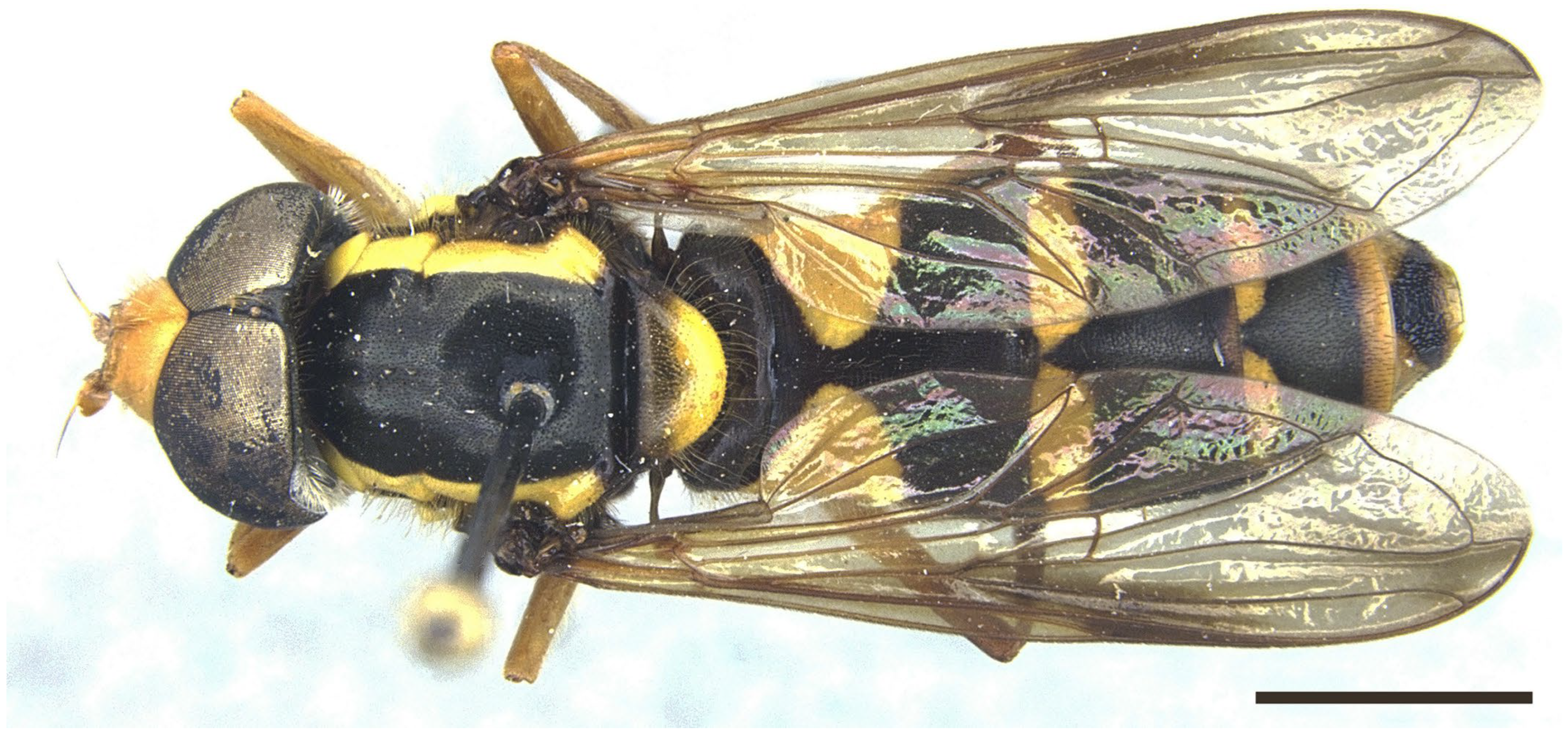

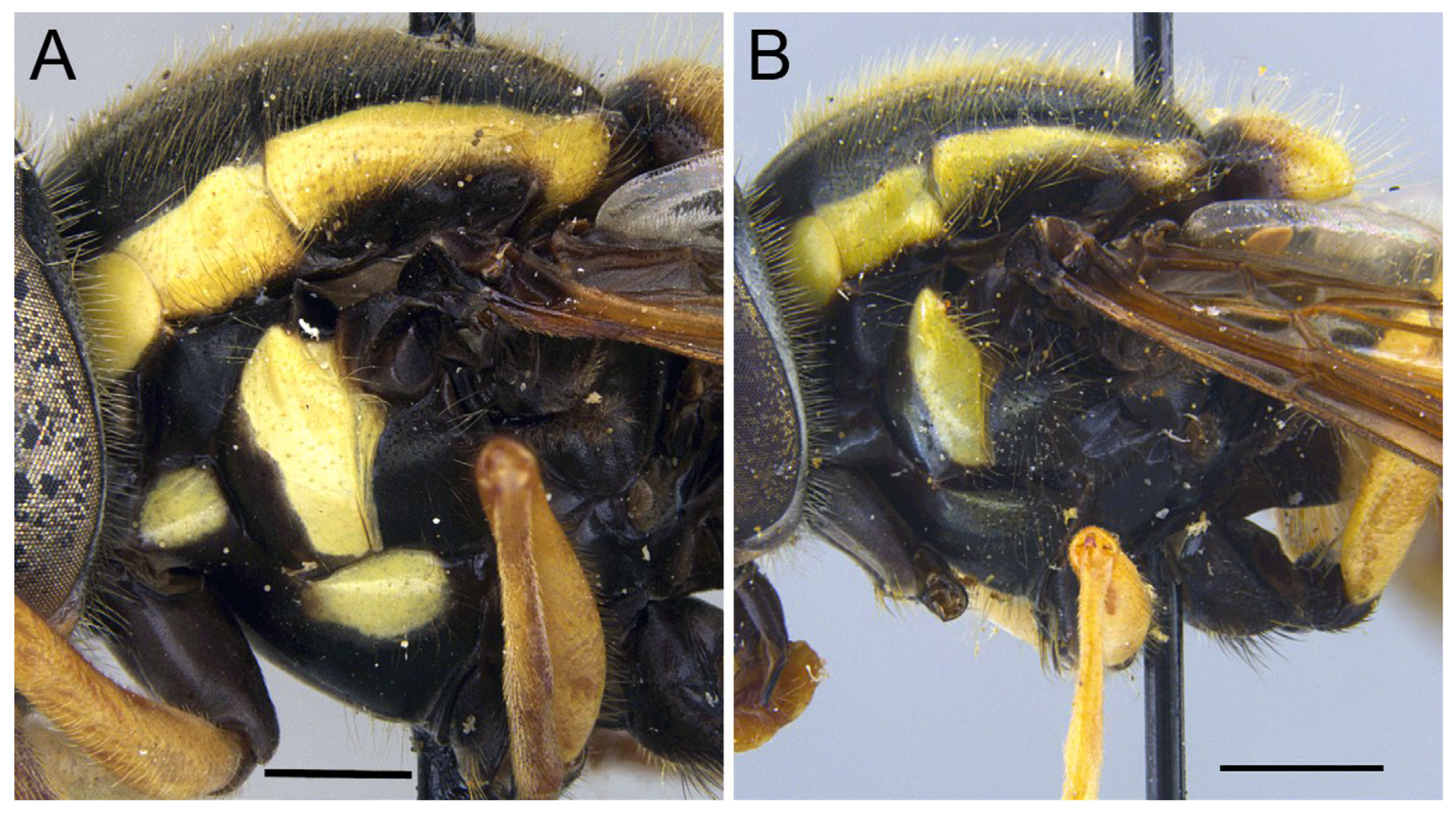
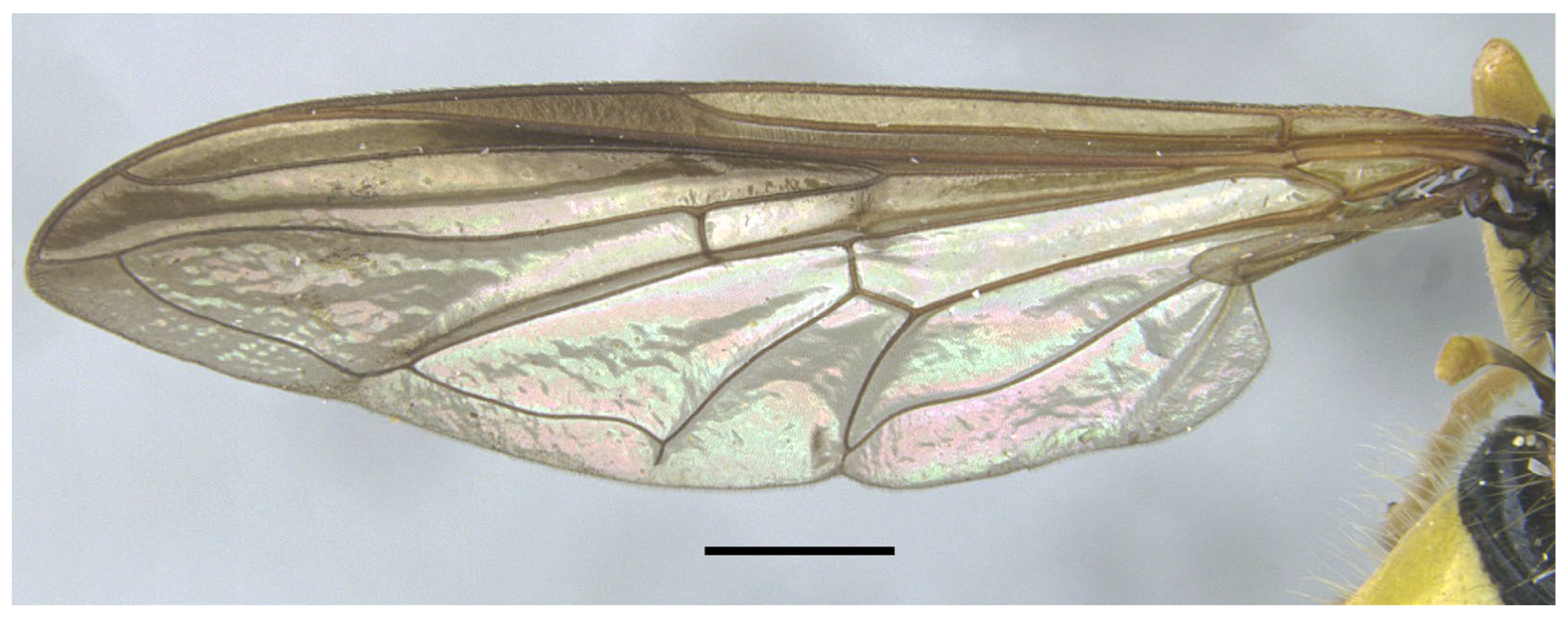

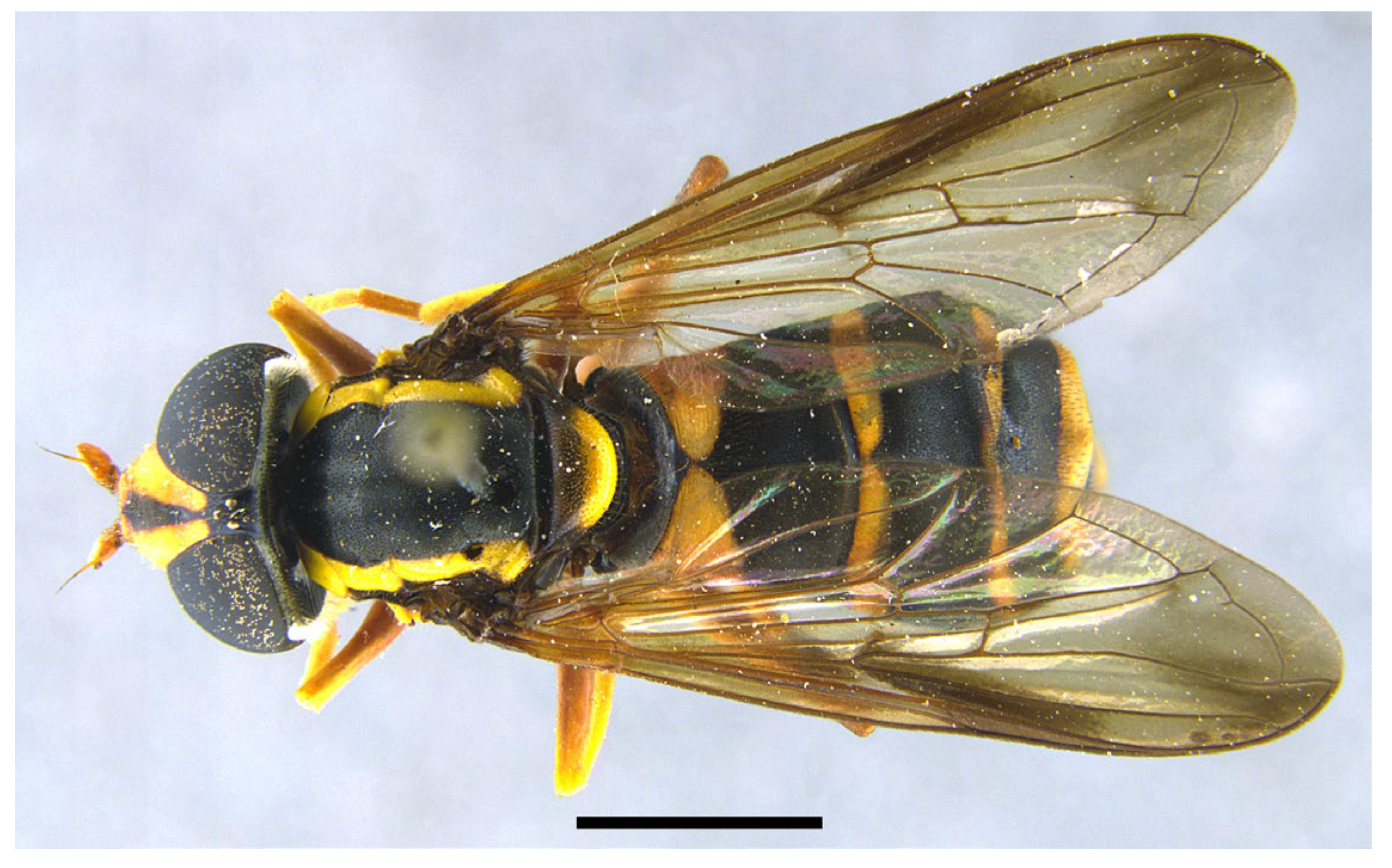
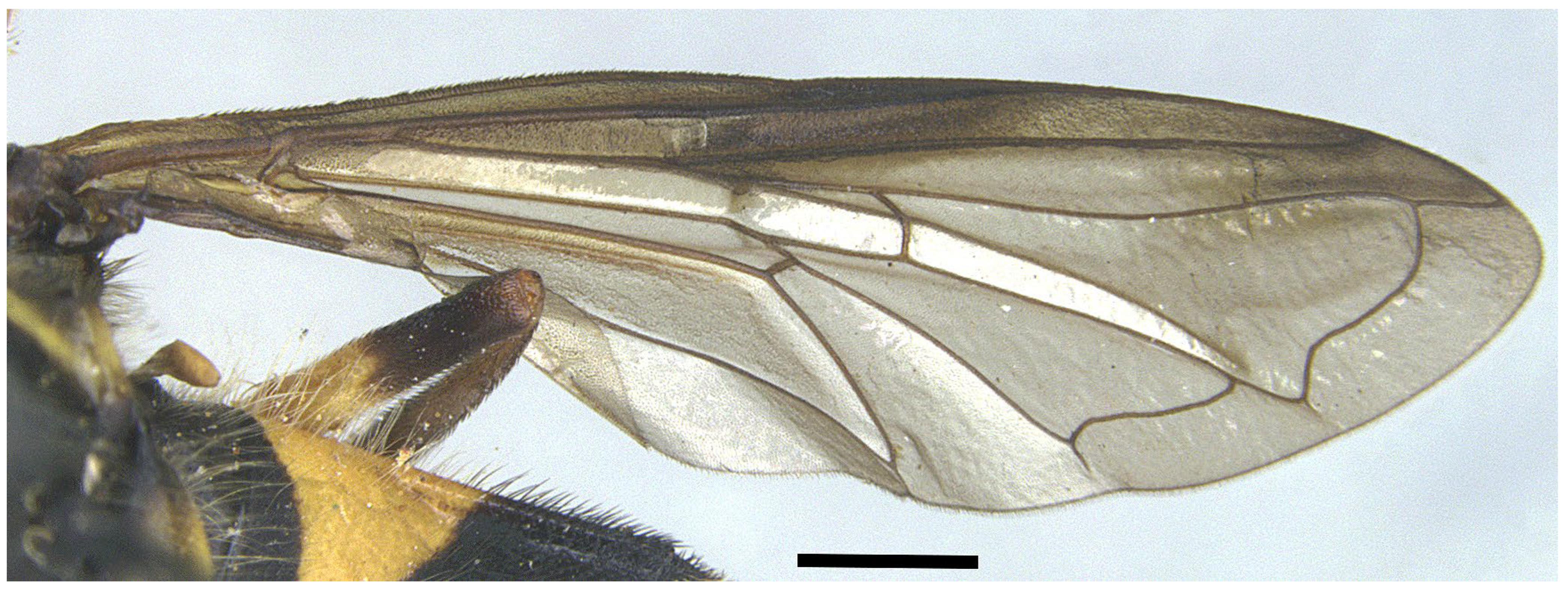
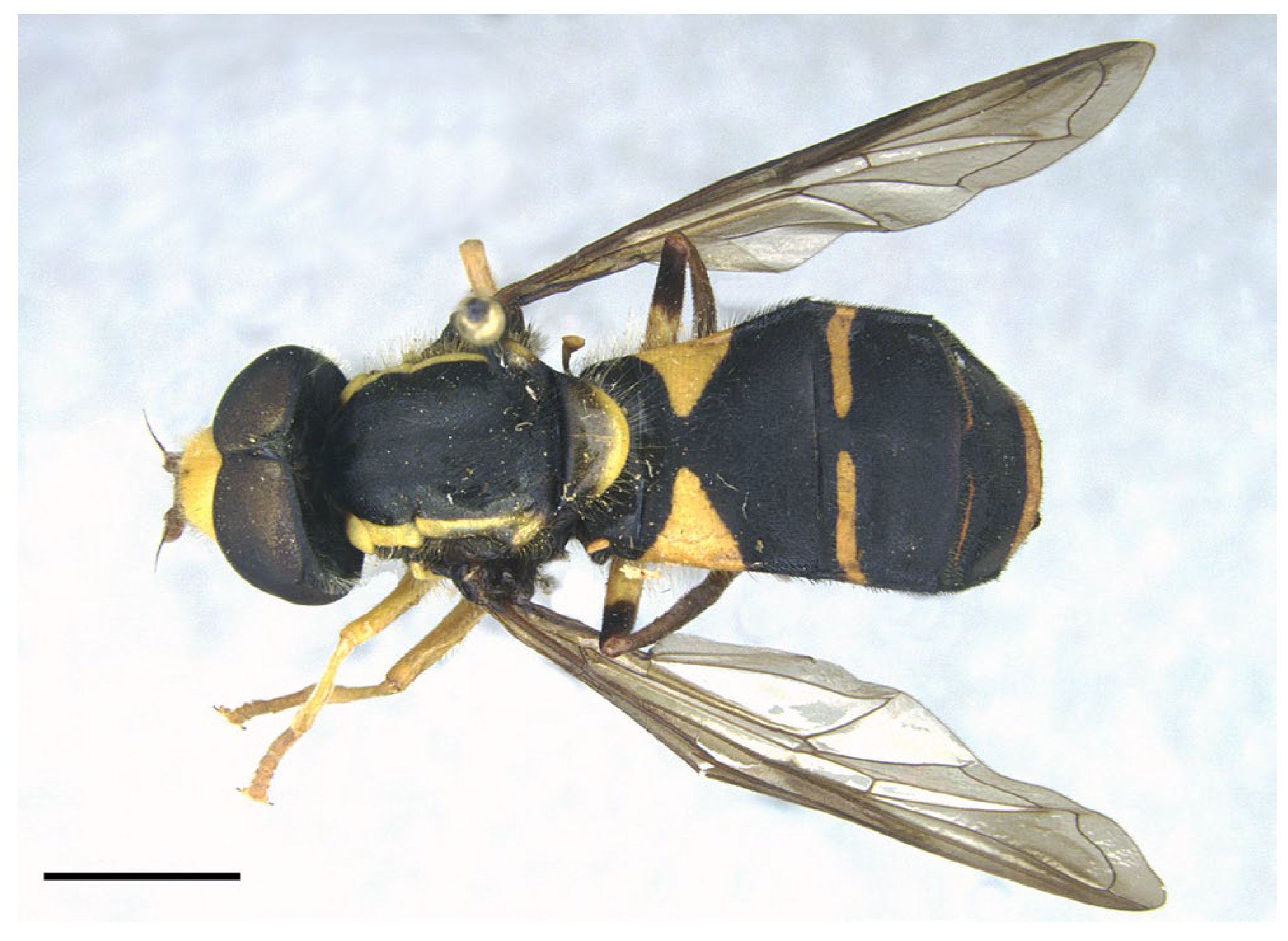
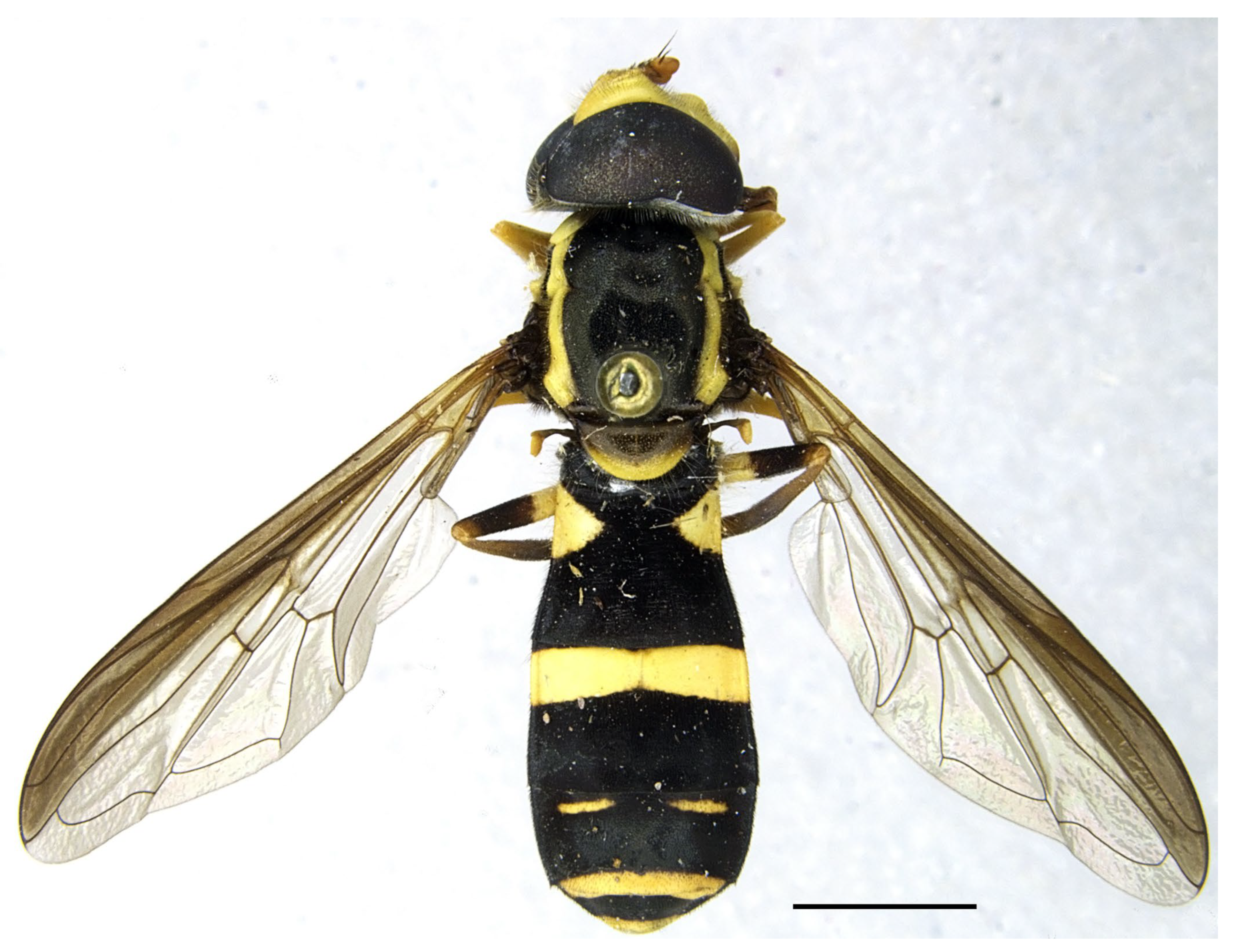
Disclaimer/Publisher’s Note: The statements, opinions and data contained in all publications are solely those of the individual author(s) and contributor(s) and not of MDPI and/or the editor(s). MDPI and/or the editor(s) disclaim responsibility for any injury to people or property resulting from any ideas, methods, instructions or products referred to in the content. |
© 2025 by the authors. Licensee MDPI, Basel, Switzerland. This article is an open access article distributed under the terms and conditions of the Creative Commons Attribution (CC BY) license (https://creativecommons.org/licenses/by/4.0/).
Share and Cite
Nedeljković, Z.; Mengual, X.; Ricarte, A. Revision of the North African Hoverflies of the Genus Xanthogramma Schiner, 1861 (Diptera: Syrphidae), with Description of a New Species. Insects 2025, 16, 758. https://doi.org/10.3390/insects16080758
Nedeljković Z, Mengual X, Ricarte A. Revision of the North African Hoverflies of the Genus Xanthogramma Schiner, 1861 (Diptera: Syrphidae), with Description of a New Species. Insects. 2025; 16(8):758. https://doi.org/10.3390/insects16080758
Chicago/Turabian StyleNedeljković, Zorica, Ximo Mengual, and Antonio Ricarte. 2025. "Revision of the North African Hoverflies of the Genus Xanthogramma Schiner, 1861 (Diptera: Syrphidae), with Description of a New Species" Insects 16, no. 8: 758. https://doi.org/10.3390/insects16080758
APA StyleNedeljković, Z., Mengual, X., & Ricarte, A. (2025). Revision of the North African Hoverflies of the Genus Xanthogramma Schiner, 1861 (Diptera: Syrphidae), with Description of a New Species. Insects, 16(8), 758. https://doi.org/10.3390/insects16080758





